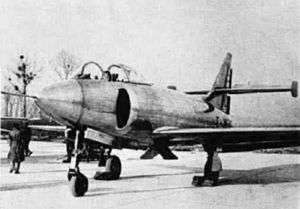SNCAC NC 1080
| SNCAC NC.1080 | |
|---|---|
 | |
| Role | Single seater monoplane |
| National origin | France |
| Manufacturer | SNCAC (Société Nationale de Constructions Aéronautiques du Centre) |
| Designer | Germain Pillon |
| First flight | 29 July 1949 |
| Number built | 1 |
The SNCAC NC.1080 was a prototype single-seat carrier-based fighter aircraft first flown on 29 July 1949. Development was discontinued following an unexplained accident on 10 April 1950, and the contest, for which the design was intended, was eventually rendered moot when the Aéronavale adopted the de Havilland Sea Venom in 1952.
Design and development
Conceived as a single-seat, carrier-borne fighter for the French Navy, the NC.1080 competed for this role against the Arsenal VG 90 and Nord 2200. The project was funded directly by SNCAC, and was directed by engineer Germain Pillon.
The NC.1080 was fitted with a Rolls-Royce Nene turbojet, and was designed to be capable of carrying three 30mm cannon.[1] It was a low-wing monoplane of all-metal construction.
On 29 July 1949, the aircraft had its first test flight, during which issues were noted regarding two control surfaces: the spoilers and tailplane.[1] While SNCAC was dissolved that same year, further testing of the prototype was carried out by the French military at Brétigny and Villaroche air bases.[1] During a test flight on 10 April 1950, with Pierre Gallay at the controls, the plane crashed for unknown reasons.[2] It was damaged beyond repair.[1] Consequently, further development of the design was immediately halted.[2]
Specifications
Data from The Complete Book of Fighters [1]
General characteristics
- Crew: 1
- Length: 12.87 m (42 ft 2⅝ in)
- Wingspan: 12.00 m (39 ft 4½ in)
- Height: 4.70 m (15 ft 5 in)
- Wing area: 28.4 m² (306 sq ft)
- Empty weight: 5,141 kg (11,334 lb)
- Loaded weight: 7,700 kg (16,975 lb)
- Powerplant: 1 × Rolls-Royce Nene turbojet, 22.3 kN (5,000 lbf)
Performance
- Maximum speed: 978 km/h (529 knots, 608 mph) at 5,000 m (29,500 ft)
- Range: 1,550 km (837 nmi, 963 mi)
- Rate of climb: 25 m/s (4,920 ft/min)
Armament
- Guns: 3× 30 mm (1.181 in) cannon (planned)
References
- Green, W. & Swanborough, G. (1994). The Complete Book of Fighters. London: Salamander Books. ISBN 1-85833-777-1
External links
| Wikimedia Commons has media related to SNCAC NC 1080. |